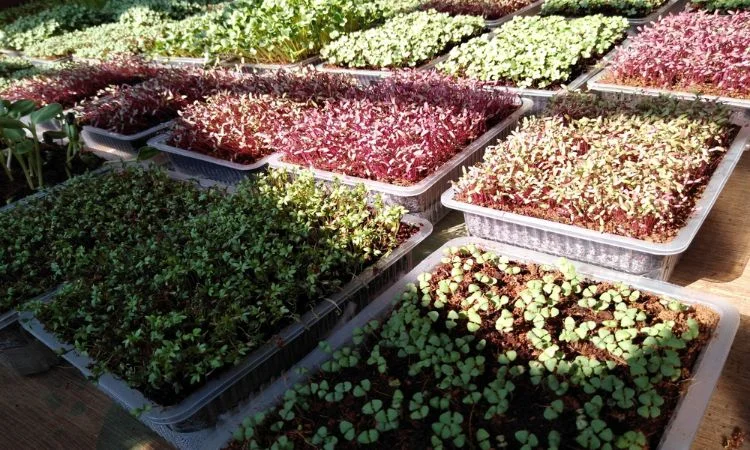Covid-19 arrived and completely altered our lives, from our routine to our food habits. As the epidemic raises health concerns and priorities, Indians are becoming more health-conscious than ever. According to industry analysts, the compounded growth of organic food in India might climb by at least 20-25 percent in the year 2022-22. One of the most significant lessons individuals learned was the importance of developing robust immunity as a possible defense against some fatal illnesses.
Organic foods, which are high in antioxidants and minerals, are one of the greatest methods to increase immunity. As a result, rather than jeopardizing their health further, consumers will opt to buy organic food and even pay a premium for it. Given the circumstances, it is possible to conclude that now is an excellent moment to invest in a Microgreen Business in India. In this post, we will discuss all you need to know about the Microgreen company in India, as well as how to get started.

Microgreens are well-known for their simplicity of cultivation, and delicacy in a wide range of meals across the world. People in many nations throughout the world are including various types of microgreens in their diets. Let us now look at how microgreens are employed in India.
Many microgreen kinds are utilized in Indian and Indian cuisine, including fenugreek-methi, mustard, wheatgrass, coriander, Bengal gram, and mung bean. Indians enjoy adding these microgreens to their cuisine because they grow quickly and have a delicious flavor. Its popularity is growing by the day. They provide a wealth of nutrients to your dish, which is why they are commonly recognized as superfoods.
Microgreens developed from Indian kitchen waste
Each microgreen has its flavor. These plants have been scientifically demonstrated to provide several health advantages in addition to providing flavor to salads and toasts. You don’t have to go out and buy them; instead, you may cultivate some of them at home using seeds that are already in an Indian kitchen. Do you know what those crops are?
MICROGREENS OF WHITE MUSTARD
Here is the list, as well as further information:
- Lentils and pulses such as rajma, lobia, chickpea, and moong are readily accessible in all Indian households. Because they take up little room, you may use them to produce these little vegetables in your kitchen.
- Fenugreek/methi, mustard, and other spices (Indian mustard in black color). These seeds are commonly accessible in the kitchen and may be used to develop plants. These are incredibly tasty vegetables that may be used in your recipes to enhance their flavor.
- Wheatgrass is a renowned superfood due to its numerous health advantages. Many of them do not regenerate after being harvested. However, once harvested, this super crop may regenerate quite well. It takes 2-3 days for the hair to regrow. This crop may usually be harvested twice. After then, you should cease harvesting since the crop’s sugar content will plummet dramatically. Other nutrients that are important to the crop will also be depleted over time.
- Cilantro/Coriander – This is an important crop that is used in the majority of Indian dishes. Salad, appetizer, soup, lunch, breakfast, snacks, and so on. You can simply cultivate coriander seeds from the seeds you already have in your kitchen.
How can I cultivate microgreens in my kitchen?
You may grow them in spaces such as the kitchen, garage, yard, near a window, or on a table at home. Plastic pots, soil/coco coir (growing media), and organic seeds are required to cultivate these vegetables. Make holes in the bottom of a plastic tray to drain the surplus water from the medium. Now add the coco coir, soil, or growth media of your choice. Spread the medium soil uniformly, making sure there are no huge lumps or stones. For a higher yield, it is critical to use the proper medium.
You must select high-quality, disease-free soil. Now, evenly distribute the seeds throughout the soil. Cover this with another small layer of dirt and then water it. Place another tray with no holes at the bottom to catch the surplus water that will drain from the tray. For a healthy harvest, always use fresh, high-quality organic seeds. Place another plate or container on top of the container. When seeds begin to germinate, they begin to seek sunshine and attempt to develop in the direction of obtaining sunlight.
When you cover the container, your crop will grow to an ideal length of 3-4cms. Continue to water them once or twice a day, but do not expose them to sunlight during this time. You can expose them to sunlight once they reach a particular length.
DISTINCT INDIAN SEEDS
Common issues encountered when cultivating microgreens
- The fungus caused by excessive humidity: Keep an eye out for fungal growth in your growing media. This frequently occurs when there are no drainage holes in the container in which the crop is being grown. If the fungus gets inside the seeds, throw them out and start over.
- Seeds do not germinate: Some spices we use in the kitchen absorb moisture and lose fertility to a higher extent. This is not your fault; in this instance, start with a new set of seeds for better outcomes.
- Lack of light: When the seeds germinate, they will seek out light. If they don’t get enough light, they get leggy, weaken, and fall to the ground. This is a strong indication that your plant requires sunshine. Microgreens cannot be grown under low-light conditions. If the problem persists, expose the crop to sunshine.
India’s microgreens industry
These vegetables are becoming increasingly popular as culinary ingredients, particularly among vegans who like to eat organic foods and those seeking a balanced, healthy vegetarian diet. Anyone may start this company in their garage, lawn, home, basement, or wherever.
Consider a modest space as little as 100sqft for growing these crops for personal use, if you want to plant more than just one tray. You may also expand commercially, but you’ll need a larger space – 500 to 1000 square feet. This is a great opportunity depending on your ambition and the size of the business you would like to set up under the microgreen venture.
What Exactly Is a Microgreen Business?
Microgreens Business is the earliest leaves to emerge from the herb, vegetable, or flower seeds. They are collected 14 days after seed germination. Microgreens are 40 times more nutritious than mature veggies, according to research. They are thought to be productive crops that may be cultivated in a small amount of space. You may start your microgreen company once they have matured. Microgreen enterprises may be quite successful, and you can make a lot of money from them.
If your space is limited, you will need to use an urban vertical farming approach to cultivate these crops. Plants are grown one on top of another using this innovative approach, which results in a higher yield. We also grow it on racks in this manner, and it is the greatest solution if you prefer to grow it inside. Small microgreen businesses can be launched with a few thousand rupees.
Growing trays, organic seeds, fluorescent lights, potting soil or coco coir, and a growing place are all you need. Commercially farmed microgreens are best offered to hotels, restaurants, and cafés where chefs may be inspired and incorporate them into diverse dishes.
If you want to obtain everything you need to start your own Business and don’t know where to start, we have created our online course that is quite extensive and packed with valuable information. You may find it HERE. Salads, appetizers, and many other options are possible.
India is also a large market for selling micro greens to families, as people are becoming more cognizant of the food they consume and the health advantages it provides. The Indian market offers a great possibility for these projects.
Why should you consider starting a microgreen business in India?
- This enterprise requires only a minimal amount of capital to get started. For example, for 15,000 – 15Lac rupees, you may start a decent business.
- Even a tiny space will be enough to get started.
- Because you may grow any crop at any time of year, these crops can provide you with yield all year round.
- Because this crop grows so quickly, the crop cycle is quite brief.
- The least amount of equipment is required to raise them.
- Anyone may start this business; it does not require years of expertise. However, with our assistance and our online course, this start may be smoother and error-free.
- These crops have a high market value and demand.
- It is a very profitable business, as well as a very practical business concept.
The Most Popular Microgreens in Indian Cooking
Coriander, fenugreek, fava beans, radish, mustard, chickpea, cilantro, basil, lettuce, kale, baby spinach, beet, pea shoots, mung bean, and many more are commonly used in Indian cookery.
India’s Best Microgreen Seeds
If you’re wondering where you can get the greatest microgreens seeds in India, here’s a list of options:
Broccoli, lettuce, sunflower, radishes, Tuscan kale, Thai basil, amaranthus, turnip, green basil, pea shoots, beetroot, and kale Purple kale, green kale, purple basil, purple kale, baby spinach, red cabbage, red mustard, methi/fenugreek, coriander, sango radish, fava beans, etc.
How Do You Begin a Microgreen Business in India?
Remember to conduct market research on your potential clientele before establishing your firm. Vertical farming is used to cultivate microgreens. The vertical farm grows and produces plants by stacking them. This is performed by hanging growing shelves on a wall, which takes up far less room than growing plants on the ground.

A one-time investment in metal shelves, lights, and flat trays is required to establish a small microgreen company. Microgreen farming does not require a large space; you may start your farm in as little as 6 square feet. Microgreens may even be grown in a small apartment.
Microgreens require an ideal environment to develop, with at least 16 hours of sunshine and a temperature range of 15-26 degrees Celsius. Watering should take place twice a day, once in the morning and once in the evening. One thing to bear in mind is that microgreens should be delivered as soon as they are ready.
How to Start Your Own Microgreen Business in India
- Extensive research about your market
Every market is unique, therefore spend some time before starting your microgreen company to thoroughly analyze your market and do market research while producing microgreens for profit. Examine your local marketplaces.
- Experiment with Different Marketing Strategies
Understanding client feelings is the most critical phase in Marketing. Word-of-mouth marketing is an ancient method, but it is always successful. When news spreads through the lips, it always travels quickly. The news may be both positive and unpleasant since people will be interested in both. As a result, adopt this tried-and-true marketing method to promote your company.
- Assess the Health Risk
When starting a food business, it is critical to examine the health risks. If the food product is not handled properly, the sickness can spread quickly. Handle and cultivate microgreens correctly to eliminate all health concerns.
- Take into account packaging
If you sell microgreens to a shop, there is a chance that your reputation may suffer if an employee mishandles your merchandise. This is only one of the many reasons why packaging is so crucial.
The Advantages of a Microgreen Business in India:
Starting your own microgreen business may be successful since it offers various advantages from the start. Among these advantages are:
- Microgreens may be cultivated in a little amount of area.
- Minimal investment is required.
- The crop cycle is brief.
- They may be grown indoors all year.
Is it profitable to start a microgreen business in India?
Microgreen enterprises are extremely successful in India. A microgreen company has the benefit of being able to be grown in practically any place. In India, starting and managing a microgreen market is both profitable and practicable. Many firms and startups are investing in microgreen enterprises since they are lucrative and take up less area. Anyone who wants to create a business in this field can do so.
Microgreen Business Requirements in India
When you decide to establish a Microgreen business, you must invest in a few items, some of which are one-time investments and others that are ongoing.
- One Time Investments
Lights on a metal shelf
Flat trays
Growing microgreens in a small area
- Containers with Recurring Costs Seeds
Medium
Water
Which Plants Make the Best Microgreens?
The following are some of the best plants to grow as microgreens:
- Pansies\sTomatoes
- Basil\sMint
- Sunflowers\sRadishes\sPotatoes
- Spinach
Opportunities for Business
Microgreens have a significantly shorter lifetime (1-2 weeks) than their mature counterparts (4-6 weeks). As a result, by the time you cultivate and harvest a mature vegetable or fruit, you can create three to four harvests of microgreens. Furthermore, the growth of microgreens does not need a large field. It is simple to cultivate in small backyards or even on terraces.
All they require is direct sunshine and regular watering. As a result, small-scale farmers may readily implement this and significantly increase their earnings. Microgreens have a high monetary value. You may earn up to INR 150 per 100 gram of radish or pea-shoot microgreens. Surprisingly, 100-gram microgreens require a space the size of a disposable pie plate.
Government Assistance: To assist farmers and enterprises that rely on the Agriculture industry for raw materials, the Ministry of Agriculture has two devoted wings: the Department of Agriculture Research and Education and the Department of Agriculture, Co-operation, and Farmers Welfare. Farmers may get low-interest horticultural loans from all major banks, including SBI and ICICI.
Why are microgreens so popular?
This is mostly due to their high nutritional value. According to a study conducted by the University of Maryland College of Agriculture and Natural Resources (AGNR) and the United States Department of Agriculture (USDA), microgreens offer higher nutritional content than their mature counterparts. Their study team estimated the amount of Vitamin C, E, K, and beta-carotene in 25 microgreens and their adult counterparts. Microgreens were discovered to have 4 to 40 times more nutrients than their adult counterparts.
Conclusion
In this fast-food era, we must remember to consume a plate full of a good nutritional meal. Intake of nutritious foods, in turn, increases the levels of vitamins, minerals, protein, antioxidants, and a variety of other vital elements. We should cease relying solely on medications to meet our bodies’ nutritional needs; instead, we should start eating properly to meet our bodies’ day-to-day needs.
Microgreens are one such wonderful gift that we may incorporate into our diet to improve our general health for the least amount of money and effort. It also aids in the treatment of significant illnesses that arise in the human body. So remember to include a handful of microgreens on your plate at every meal!
Because every market is distinct, starting and expanding a microgreen business may take some time and work, but consistency is vital. To expand your firm, conduct significant market research, and successfully advertise your goods. Given the circumstances, it is possible to conclude that now is an excellent moment to invest in a Microgreens Business in India.
FAQs
How much money do you need to start a microgreen company in India?
The investment necessary to establish your own microgreen business might range from INR 15,000 to INR 5 lakhs.
What is the smallest amount of room needed to cultivate microgreens?
You may start a farm in as little as 6 square feet. Microgreens may also be grown in a tiny flat.
Is selling microgreens profitable?
Yes, starting and managing a microgreens market in India is both profitable and practicable.
Microgreens demand what sort of soil?
For growing your microgreens, use any organic potting soil.















